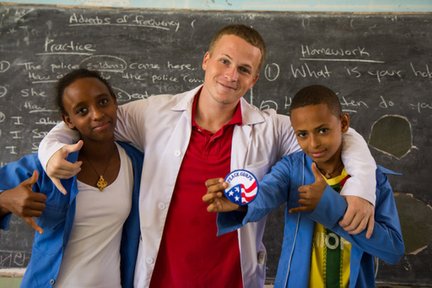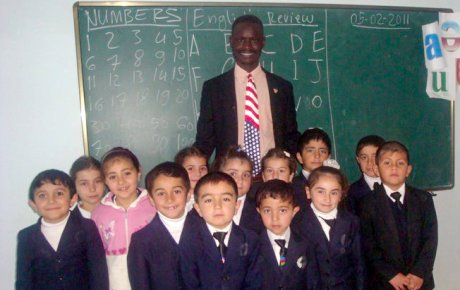Peace Corps Ethiopia has more than 200 Volunteers engaged in three sectors: education, health and environment. The education program is our largest, with about 50 percent of Volunteers working as English teachers in local high schools. This was our second school visit and fourth Volunteer visit of the day. We were working our way through the region to visit Volunteers in their sites and photograph them working.
So I found myself rolling down this dusty road with Yohannes, one of our Peace Corps drivers, looking for the school compound on the outskirts of town, surrounded by farmlands, drying in the unrelenting sun of post-rainy season Tigray.
After finding the entrance I called PCV Ally, who led us into the school. I was right on time for her third section of the day. Every day she teaches four sections of English with about 70 kids in each class.
2015-11-16-pc-teachers-in-tigray-12.jpg
 Peace Corps Volunteer Ally teaches four sections of English, with about 70 kids in each class.
Peace Corps Volunteer Ally teaches four sections of English, with about 70 kids in each class.
Today the lesson was about “do” and “make” and how to use them properly. Ally’s been teaching classes in Tigray for more than a year and is now almost midway through her second academic year as a high school English teacher in Ethiopia. The students are comfortable with her and were amazingly energetic to participate. This is surprising since some students I’ve seen over the years in Ethiopia are painfully shy; what I would consider insubordination in the States is unfortunately a common manifestation of modesty so I was surprised by their unabashed enthusiasm.
Ally led the students through the theory portion of the lesson and then moved on to practice by asking students to volunteer to come up front read an activity written on a slip of paper and decide if one “does” it or “makes” it. The students were usually correct but when they struggled their peers helped or Ally offered guidance. What was so surprising was how excited the students were to meet this challenge; they were standing in the back of the room in order to see the examples and write them down in their notebooks, hands were raised constantly to earn a chance to be heard.
But this didn’t happen overnight. Many of these Peace Corps teachers start on thin ice and through sheer stubbornness, dedication and good old-fashioned hard work slowly build their skills, integration and trust in the schools and towns of rural Ethiopia.
Earlier in the day we visited Kimber, one of the newest Volunteers in Ethiopia. She came to Ethiopia with Group 13 and had been teaching for about two months when we visited. We watched Kimber ready for the day’s lessons about the present continuous tense. The previous night, she had prepared immaculate notes to clearly and concisely convey the lesson and meticulously transcribed them to the chalkboard.
Kimber pushed hard to have her own dedicated teaching space. Unlike my high school in America, most Ethiopian high schools make the teachers move between classrooms while the students stay put. This means teachers don’t have their own dedicated space. Having her own space gives Kimber a controlled environment and allows her to make it a welcoming English language learning space. This model classroom got a fresh coat of paint a few weeks ago and the students themselves ran home after class one day to fetch water, brooms and mops to clean the room.
2015-11-16-pc-teachers-in-tigray-14.jpg
 The students are comfortable with Ally and were amazingly energetic to participate.
The students are comfortable with Ally and were amazingly energetic to participate.
While Kimber prepared the room for the lesson, we discussed the difficulties of education in Ethiopian and ways to improve it. How do you keep rats from living inside the chalkboard frame? How do you work with students who, despite being in the same grade, have drastically different English competency? How do you bring quality education to more than 2,000 kids with 50 or 60 teachers, as is the case at this school? How do you encourage students, and more importantly their families, to prioritize schooling despite conflicting pressures and domestic duties? These are just a few of the questions Kimber and her fellow Volunteers begin to answer throughout their two years of service.
We stayed for her first class of the day before we had to move on. The kids were interested, engaged and copied down all the notes. One girl even sacrificed her shoe to allow another student to borrow a pen for note taking (Kimber implements a policy: if you borrow a pen from Teacher Kimber, you have to leave a shoe–very effective insurance against pens walking away).
The previous day we met PCV Matt in another nearby town. We picked him up as he was walking to school in the morning. He pointed out the mountains where he’s working with some local farmers to document the existence of wild mountain lions. These coy cats are known to be in the area but Matt wants to get one on camera and devotes a considerable amount of his free time to the endeavor. What else are you going to do for fun in a dusty Tigray town?
As we arrived at his school and greeted the staff, we also bumped into Eddie Vedder, or rather 10 of them. Last year Matt taught his English students the lyrics to Pearl Jam’s "Even Flow," partially as a joke and partially as a fun way to end every class. They ended up making a full cover of the song with the school's youth as Eddie Vedder. It was uploaded to YouTube and currently has over 50,000 views!
2015-11-16-pc-teachers-in-tigray-50.jpg
 Peace Corps Volunteer Matt taught his English students the lyrics to Pearl Jam’s "Even Flow" -- their video cover of the song has more than 50,000 views on YouTube.
Peace Corps Volunteer Matt taught his English students the lyrics to Pearl Jam’s "Even Flow" -- their video cover of the song has more than 50,000 views on YouTube.
I followed Matt to his three sections of the day where he taught 9th graders about adverbs of frequency (for example: “I often listen to Seattle grunge music.”). Throughout the class Matt called on his students by name, despite having more than 150 kids in his sections. Matt ended each class with a bit of Nirvana’s "Smells Like Teen Spirit." The kids are already done shooting the video and can’t wait to become the rock stars of last year’s class, now in grade 10. Matt says the 10th graders yell bits of “Even Flow” across the school grounds to the 9th graders, who respond with Nirvana quotes in a strange battle-of-the-bands sparring match.
After our final visit, as Yohannes drove into the late afternoon light of northern Ethiopia, I thought to myself how inspiring this short trip was. It’s incredible to see this kind of impact! Throughout my service I found that my most rewarding and fulfilling “work” experiences came from engaging youth. Collectively, Volunteers have the opportunity to engage thousands of kids every day.
It’s exciting to see our Volunteers reaching so many kids. In 2015, Peace Corps Volunteers in Ethiopia taught 12,358 students. That’s enough to fill 882 minibuses! And if that weren’t enough, many of our Volunteers are involved in other extracurricular activities with their students; they cover gender equality, self-esteem, leadership, health and more. This year, 6,024 students participated in additional extracurricular activities.
These Volunteers are dedicated. They work around frustratingly flexible local holiday schedules that cancel days or weeks of classes out of the blue. They mentally map out how to effectively use a blackboard that has holes in it. They find ways to engage a classroom of diverse skill levels. They find the energy and passion to keep trying after falling, back-sliding, and struggling through various obstacles.
And finally, they find that they’ve made an impact. I see this impact almost every day as I review blogs, follow Facebook feeds and hear stories from former Peace Corps students. It’s hard to remember to see the big picture when you’ve got your head down at site and are focused on one school, one class or even just one student, so I just want to say cheers to all those Peace Corps teachers out there. You rock.



